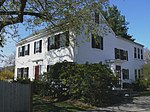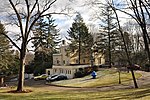Henry Grover House
Houses on the National Register of Historic Places in Winchester, MassachusettsWinchester, Massachusetts Registered Historic Place stubs

The Henry Grover House is a historic house at 223–225 Cambridge Street in Winchester, Massachusetts. The wood-frame 2+1⁄2-story double house was built in the 1880s by Henry Grover, who farmed 25 acres (10 ha) of surrounding land. In the late 20th century, the Purcell family operated a flower stand on the property known as "Purcell's Pansy Patch". When the site was developed for housing beginning in 2009, the house was rehabilitated as part of the development.The house was built in 1885 and added to the National Register of Historic Places in 1989.
Excerpt from the Wikipedia article Henry Grover House (License: CC BY-SA 3.0, Authors, Images).Henry Grover House
Cambridge Street,
Geographical coordinates (GPS) Address Nearby Places Show on map
Geographical coordinates (GPS)
| Latitude | Longitude |
|---|---|
| N 42.453611111111 ° | E -71.158611111111 ° |
Address
Cambridge Street 228
01890
Massachusetts, United States
Open on Google Maps










